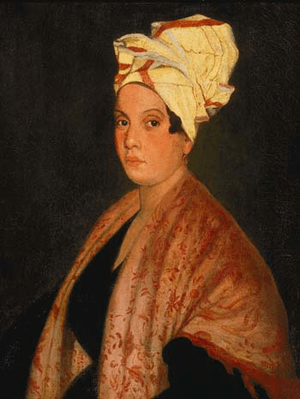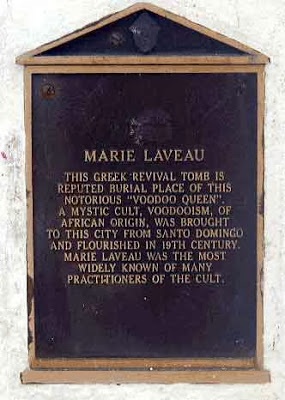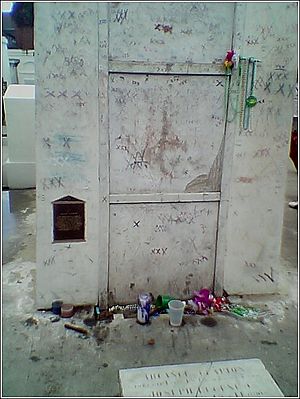Marie Laveau facts for kids
Quick facts for kids
Marie Laveau
|
|
|---|---|
| Marie Laveaux | |

1920 portrait by Frank Schneider, based on a lost 1835 painting by George Catlin (Louisiana State Museum)
|
|
| Born |
Marie Catherine Laveau
September 10, 1801 |
| Died | June 15, 1881 (aged 79) New Orleans, Louisiana, U.S.
|
| Resting place | Saint Louis Cemetery No. 1 |
| Nationality | American |
| Occupation | Occultist, voodoo priestess, midwife, nurse, herbalist |
| Known for | Voodoo Queen of New Orleans |
| Spouse(s) | Jacques Paris, Christophe Glapion |
| Parent(s) | Charles Laveau and Marguerite Henry (known as D'Arcantel) |
| Marie Laveau | |
|---|---|
| Voodoo Queen of New Orleans | |
| Born | September 10, 1801 New Orleans, Louisiana (New France) |
| Died | June 15, 1881 (aged 79) New Orleans, Louisiana, U.S. |
| Venerated in | Louisiana Voodoo, Folk Catholicism |
| Major shrine | International Shrine of Marie Laveau , New Orleans Healing Center circa 2015 |
| Feast | June 23 |
| Attributes | Water, Roosters |
| Patronage | Mothers, Children, Fevers, Love, Volunteerism |
|
Tradition or genre
|
Folk Catholicism Louisiana Voodoo |
Marie Catherine Laveau (born September 10, 1801, died June 15, 1881) was a famous woman from New Orleans. She was a Louisiana Creole who practiced Louisiana Voodoo. She was also an herbalist (someone who uses plants for medicine) and a midwife (someone who helps deliver babies).
Her daughter, Marie Laveau II, also followed similar spiritual practices. Sometimes her name is spelled Laveaux, which is the original French way.
Contents
Marie Laveau's Early Life
Marie Laveau was born in New Orleans on September 10, 1801. At that time, New Orleans was part of Louisiana (New France). She was born a free woman of color.
Her father was Charles Laveau Trudeau, a white Frenchman and politician. Her mother, Marguerite D'Arcantel, was a free woman of color. Marguerite had white, black, and Native American ancestors.
Marriage and Family
On August 4, 1819, Marie Laveau married Jacques Paris. He was a free man of color who came from Haiti. He had fled the Haitian Revolution. Their marriage record is kept in the St. Louis Cathedral in New Orleans.
Jacques Paris worked as a carpenter. They had two daughters, Felicite and Angele. Both daughters disappeared from records in the 1820s. Jacques Paris died in 1820.
Marie Laveau's Personal Life
After Jacques Paris died, Marie Laveau lived with Christophe Dominick Duminy de Glapion. He was a nobleman of French descent. They lived together until he died in 1855.
They had seven children, according to birth and baptism records. Only two of their daughters lived to be adults. Their names were Marie Eucharist Eloise Laveau and Marie Philomene Glapion.
Community Work
Marie Laveau was known for helping people in her community. She visited prisoners who were sentenced to death. She would prepare their last meal and pray with them. She also tried to get pardons for some prisoners.
During the yellow fever epidemic of 1878, she cared for the sick. She gave them herbal remedies and prayed for them. She also taught women in the community and performed rituals for those who needed help, often without charging money.
Marie Laveau's Career
Marie Laveau was a dedicated Voodoo practitioner and healer. She was also an herbalist and an entrepreneur. She was a respected religious leader and community activist.
Beauty Parlor and Voodoo
Laveau owned a beauty parlor where she worked as a hairdresser. Her clients were often wealthy families in New Orleans. She was very good at getting information from her clients. She would listen to their gossip or talk to their servants.
She used this information during her Voodoo consultations. This helped her seem like a clairvoyant (someone who can see the future). She also sold gris-gris (charms) to her clients. These charms were meant to help their wishes come true.
People often asked Laveau for help with family problems, health issues, and money. She offered her services at her home, in Go Square, and at Lake Pontchartrain.
Marie Laveau was a powerful leader in New Orleans Voodoo. After she died, the number of Voodoo followers in New Orleans decreased. Her daughter, Marie Laveau II, continued some of her practices. She held public events, including rituals on Saint John's Eve.
Marie Laveau's Death

Marie Catherine Laveau Paris Glapion died on June 15, 1881. She was 79 years old. There are different spellings of her last name because many women in New Orleans had similar names at that time.
On June 17, 1881, newspapers announced that Marie Laveau had died peacefully at home. Her funeral was grand, and many different people attended. Some stories say that people saw her in town after she supposedly died. News of her death was reported in newspapers across the country.
At least two of her daughters were named Marie. This was a French Catholic tradition. One of her daughters, also named Marie, may have taken over her mother's role as the Voodoo Queen.
Marie Laveau's Legacy
Marie Laveau's name and story are surrounded by legends. Many people believe she is buried in the Glapion family crypt in Saint Louis Cemetery No. 1 in New Orleans.
Tourists still visit her tomb. A tradition says that if you want a wish granted, you should draw an "X" on the tomb. Then, you turn around three times, knock on the tomb, and say your wish. If your wish comes true, you come back, circle your "X," and leave an offering.
Since March 1, 2015, you need a tour guide to enter St. Louis Cemetery No. 1. This rule was made to protect the tombs from damage.
See also
 In Spanish: Marie Laveau para niños
In Spanish: Marie Laveau para niños
- Mary Oneida Toups


